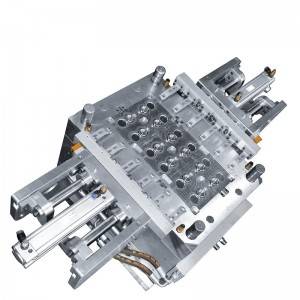Plastic injection molds are mainly divided into static and dynamic molds. The mold with sprue bushing on the side of the injection head of the injection molding machine is a static mold. A static mold usually consists of a sprue, base plate and template. In simple shapes, it is also possible to use a thicker template without using a backing plate. The sprue bushing is usually a standard part and is not recommended to be discarded unless there is a special reason. The use of a sprue bushing facilitates mold set-up, easy mold replacement and no need to polish it yourself.
Some special sprue bushings can be drilled or cut along a tapered line. When some forms need to be statically retrieved from a form, a static form retrieval mechanism must be added. The structure of a moving mold is usually a moving template, a movable mold base plate, an ejection mechanism, a mold leg, and a fixed setting plate.
In addition to the scraper bar, the demoulding mechanism also has a return bar, and some molds also need to add springs to implement features such as automatic demolding. There are also rail racks, cooling water holes, rails, etc., which are also the main structure of the mold. Of course, the slant guide mold also has slant guide boxes, slant guide columns, and so on. For complex products, first draw product drawings, and then determine the dimensions of the mold. The existing mold mainly needs heat treatment to increase the hardness of the mold and increase its service life. Before heat treatment, the template is pre-processed: drilling a guide post hole, a return hole (moving mold), a cavity hole, a screw hole, a gate bushing hole (moving mold), a cooling water hole, etc., milling a slider, cavities, and some molds should also be milled with slant guide boxes, etc. At present, cr12, cr12mov, and some professional steels are commonly used in regular precision mold templates. The hardness of cr12 should not be too high, and they often crack at 60 degrees HRC. Overall hardness patterns is usually around 55 degrees HRC. Core hardness can be higher than HRC58. If the material is 3Cr2w8v, the surface hardness should be nitrided after fabrication, the hardness should be higher than HRC58, and the thicker the nitrided layer, the better.
The gate is directly related to the aesthetics of the plastic part: if the design of the gate is of poor quality, it is easy to make defects. It is easy to create a serpentine flow without any obstruction. For products with high requirements, overflow and exhaust should also be provided. The ejector pin can be used for overflow, and there should be no overflow protrusions on the formwork so as not to affect the life of the mold. There are more and more mold design software, and most of them rarely use pencils to draw mold drawings.
Post time: Sep-28-2023
